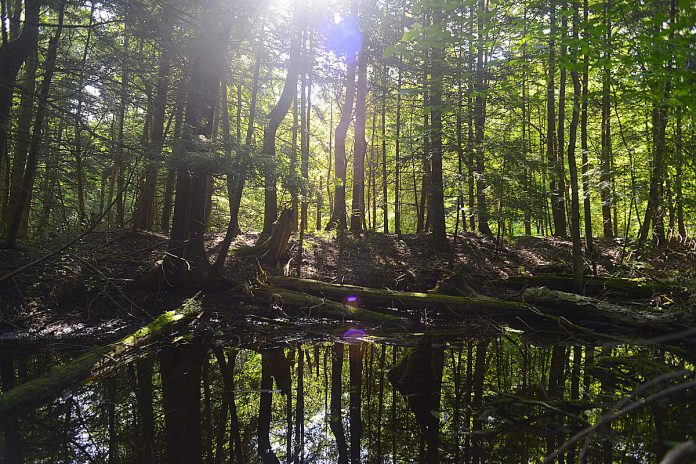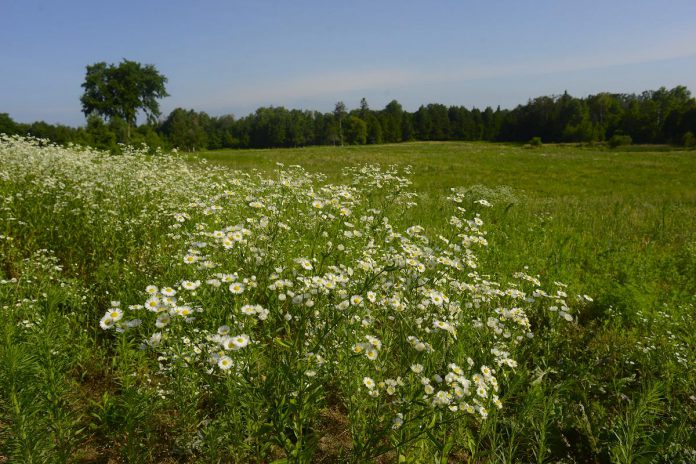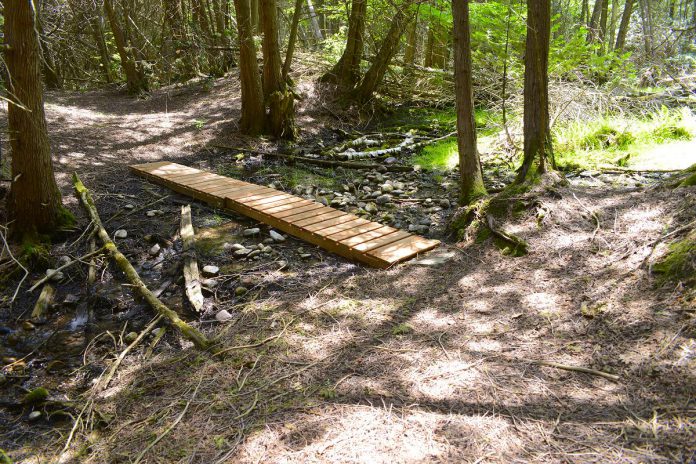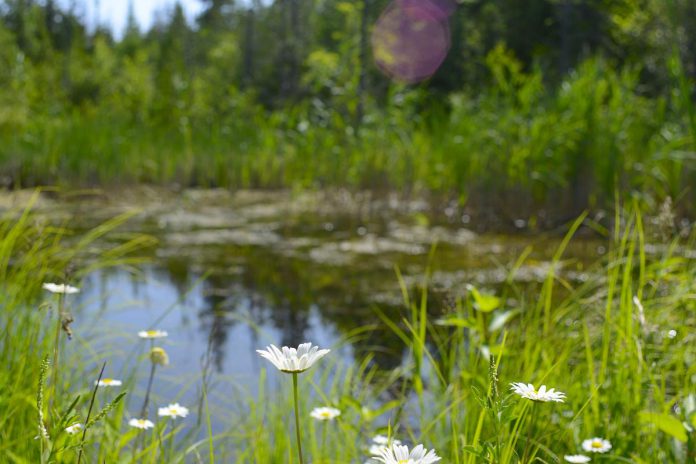
For more than a few of us, the fight to protect natural habitat areas from extinction has started and ended with well-publicized encroachments on urban green spaces in communities like Peterborough.
But there’s a whole other natural world out there in the Kawarthas and Thom Unrau, Land Stewardship Manager with Kawartha Land Trust (KLT), is on the front lines of ensuring generations to come will be able to reap the benefits of protected natural landscapes across the region.
Since 2018, KLT’s Partners In Conservation project has enabled the stewardship of some 2,400 acres of land via its partnership with 20 private landowners whose property has been identified as having significant conservation value. Working collaboratively with the landowners, KLT has improved aquatic connectivity and habitat diversity while ensuring their protection into the future.

With his KLT colleagues, Unrau works to forge relationships with landowners in the hope they are inspired to sustainably manage their both their natural and working land, ensuring the “best parts” of their property are protected from future threats, urban sprawl chiefly among them.
“What we’re doing is meeting landowners where they’re at and celebrating what they’re doing already,” says Unrau. “Everybody loves the environment. We find that everyone tries to find ways to reduce any harm as a result of their actions. The more support there is to do this, the better the outcomes tend to be.”
The Partners In Conservation project is aptly named, as KLT approaches landowners with the understanding they are equally motivated to enhance and protect the natural features of their properties.
“We should applaud them for the conservation work they’re doing and thank them,” he explains. “Everybody benefits from a beautiful rural landscape — from local food produced by farmers to beautiful trees and woodlots we get to drive past. A lot of landowners have been regulated more than they’ve been encouraged and thanked. This is to encourage them and thank them rather than increase regulation.”

Partners In Conservation takes a typically two-tiered approach when working with landowners.
Initially, KLT shares information with landowners about their property’s contribution to conservation. Central to that is a visit to the property and the subsequent preparation of a site-specific stewardship guide that lists the habitats and species observed and the significant landscape features, and makes recommendations regarding the property’s protection and enhancement.
That done, the facilitation of land stewardship is undertaken. That process sees the provision of expert advice and research on stewardship projects, administrative support for connection with other agencies offering grant funding and cost-sharing options, and on-site support from trained KLT staff.
Finally, there’s the offer of a voluntary land protection option that assists the landowner in realizing his or her vision for their land’s protection in perpetuity.
While acknowledging there is an “urgency” to ensure the protection of the environmental health of rural properties, Unrau admits KLT’s 20 partnerships to date “is a small number compared to the need.”
“But I continue to be inspired by landowners’ willingness to collaborate when they’re offered the opportunity, by their willingness to spend money on their properties to the benefit of the environment and to do good on their land and see it improved,” he says. “Our goal is to find people inspired to do that and see how they can continue to do it, or do it more.”

Inspiring landowners to look at their properties through the lens of conservation is an important part of Partners In Conservation, according to Unrau.
“I feel there’s always something someone can learn about a property they’ve spent their whole life on,” he explains. “A different person coming in and talking about their land in a certain way maybe gets them thinking about something they hadn’t thought about before. We’re not coming at landowners thinking we need to educate them because they’re ignorant. Rather we want to inspire them so we can work together.”
One of KLT’s priority areas for the Partners in Conservation project is the Fleetwood Creek Watershed, situated between Pontypool and Omemee along Ski Hill Road through Bethany.
According to Unrau, the area has been identified as having an outstanding amount of connected natural land and good water quality — all of which contribute to climate change resilience, wildlife habitat, and overall high water quality.
Many landowners in the Fleetwood Creek area have been caring for and enhancing their land for decades. The choices they’ve already made on their properties have helped to keep the area in good ecological health.
“In Fleetwood Creek, there are approximately 150 people, families and individuals, who own the bulk of the land,” says Unrau. “What happens if we can talk to all of them and have relationships? What can we learn that we can do together to secure the landscapes we want to see there in the future? What kind of collective impact on the future can we have if we work together?”

Unrau notes the pandemic has provided somewhat of a boost to the spirit behind the Partners In Conservation project.
“When things were shut down, particularly early on, all one really could do is go outside,” he says. “That reminded people that we something pretty spectacular right here in our own backyard. The more we can work together, the more likely we’ll continue to have that spectacular thing. I think it has inspired more people to think globally and act locally.”
The challenge, adds Unrau, remains what it has always been: getting word out about the Partners In Conservation project while raising awareness of the benefits. And then there’s the challenge of securing project funding, beyond the current support of Ontario Trillium Foundation grants.
“We need to make sure we build and grow a program that people see as valuable and will support — that’s it’s creating the kind of change they want to see in their communities. People like positive things and they like things that are collaborative.”
When all is said and done, notes Unrau, the project is about encouraging landowners who are already making good decisions regarding their property to continue to do so, while introducing the benefits of responsible land stewardship to landowners who haven’t given it much thought.
“We realize that people own their rural properties for so many different reasons,” says Unrau. “We want to support them when they make choices to manage their land for nature, or when their other goals in managing land result in something that’s positive for nature. We want to congratulate and applaud them for that.”

Unrau points out that KLT’s role as a partner in conservation is to help landowners, not to judge them for their decisions about how they choose to use their land.
“If you’re a farmer, you need to farm. If you have trails or you’re a hunter, you need to do those things. Those are the reasons you own your land. We seek to act as a true partner. That’s not to say that people aren’t doing enough — they’re actually doing lots. We just need them to continue doing lots.”
On a personal level, Unrau says he’s proud of the work Kawartha Land Trust has done, and is doing, to protect land throughout the Kawarthas region.
“As much as we see the immediate benefits, there are benefits in the long-term. I think people will look back on what’s being done now and be really thankful that we worked to make our communities greater and healthier. That feels pretty good. How could it not?”
For more information about Kawartha Land Trust, details on its current protect properties, the Partners In Conservation project, and ways you can help by gifting your time, money, or property, visit kawarthalandtrust.org.
The Partners in Conservation project is funded by the Ontario Trillium Foundation, an agency of the Government of Ontario and one of Canada’s leading granting foundations. Last year, nearly $112 million was invested into 1,384 community projects and partnerships to build healthy and vibrant communities and strengthen the impact of Ontario’s non-profit sector.
The story was created in partnership with Kawartha Land Trust.


























